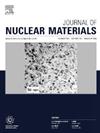静态铅铋共晶(LBE)中 316L 的摩擦腐蚀研究:350 °C 时滑移幅度和法向力对损坏机制的作用
IF 2.8
2区 工程技术
Q3 MATERIALS SCIENCE, MULTIDISCIPLINARY
引用次数: 0
摘要
铅冷快堆中不锈钢的烧蚀会影响铅冷快堆的安全。滑动幅度和法向载荷是影响烧蚀磨损行为的主要机械因素。因此,通过联合使用多种表征方法,研究了 316L 不锈钢在 350 °C 铅冷快堆中受滑动幅度和法向载荷影响的损伤机理。结果表明,法向载荷和滑移振幅主要影响接触区的切向应力和相对滑移值,从而导致不同的滑移区域和损伤机制。在混合滑移区域,损坏机制是粘着和分层裂纹。切向应力的增加导致相对滑动的减小。磨损表面附着的厚磨损碎屑层可以保护基体免受 LBE 的侵蚀。在粗滑动区域,破坏机制是磨料磨损和溶解腐蚀。相对滑动的增加会造成更多的损伤和镍的溶解,导致奥氏体向铁素体的转变和内部应变,使基体更容易受到损伤,增加了奥氏体不锈钢在 350 °C 下发生液态金属脆性(LME)的风险。因此,我们提出了不同损伤机制的模型。这些结果可为与 LBE 环境相关的烧蚀损伤提供重要信息。本文章由计算机程序翻译,如有差异,请以英文原文为准。
A study on the fretting corrosion of 316L in static lead-bismuth eutectic (LBE): The role of slip amplitude and normal force on damage mechanism at 350 °C
Fretting corrosion of stainless steel in the LBE affects the safety of lead-cooled fast reactors. Slip amplitude and normal load are the main mechanical factors affecting fretting wear behavior. Thus, the damage mechanism of 316L stainless steel at 350 °C LBE influenced by slip amplitude and normal load was investigated by jointly utilizing multiple characterization methods. The results indicate that the normal load and slip amplitude essentially affect the tangential stress and relative sliding value in the contact area, leading to different slip regions and damage mechanisms. In the mixed slip region, the damage mechanism is adhesion and delamination cracks. The increase in tangential stress leads to decrease in relative sliding. The thick wear debris layer attached to the worn surface can protect the substrate from being attacked by the LBE. In the gross slip region, the damage mechanism is abrasive wear and dissolution corrosion. The increase in relative sliding causes more damage and Ni dissolution, leading to the transformation from austenite to ferrite and internal strain, making the substrate more susceptible to damage and increasing the risk of liquid metal embrittlement (LME) of austenitic stainless steel at 350 °C. Accordingly, a model for different damage mechanisms was proposed. These results can provide important information on the fretting damage related to the LBE environment.
求助全文
通过发布文献求助,成功后即可免费获取论文全文。
去求助
来源期刊

Journal of Nuclear Materials
工程技术-材料科学:综合
CiteScore
5.70
自引率
25.80%
发文量
601
审稿时长
63 days
期刊介绍:
The Journal of Nuclear Materials publishes high quality papers in materials research for nuclear applications, primarily fission reactors, fusion reactors, and similar environments including radiation areas of charged particle accelerators. Both original research and critical review papers covering experimental, theoretical, and computational aspects of either fundamental or applied nature are welcome.
The breadth of the field is such that a wide range of processes and properties in the field of materials science and engineering is of interest to the readership, spanning atom-scale processes, microstructures, thermodynamics, mechanical properties, physical properties, and corrosion, for example.
Topics covered by JNM
Fission reactor materials, including fuels, cladding, core structures, pressure vessels, coolant interactions with materials, moderator and control components, fission product behavior.
Materials aspects of the entire fuel cycle.
Materials aspects of the actinides and their compounds.
Performance of nuclear waste materials; materials aspects of the immobilization of wastes.
Fusion reactor materials, including first walls, blankets, insulators and magnets.
Neutron and charged particle radiation effects in materials, including defects, transmutations, microstructures, phase changes and macroscopic properties.
Interaction of plasmas, ion beams, electron beams and electromagnetic radiation with materials relevant to nuclear systems.
 求助内容:
求助内容: 应助结果提醒方式:
应助结果提醒方式:


